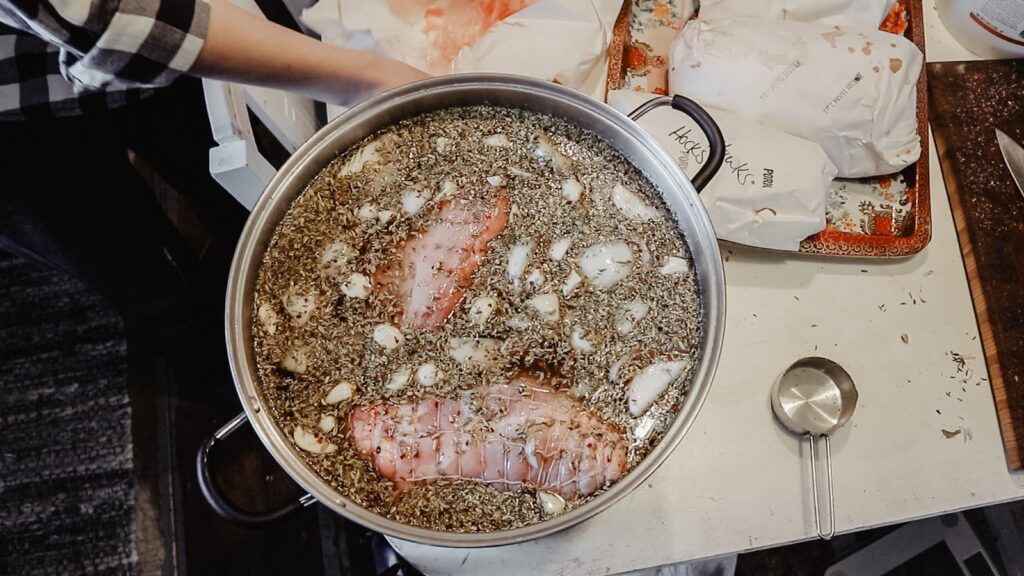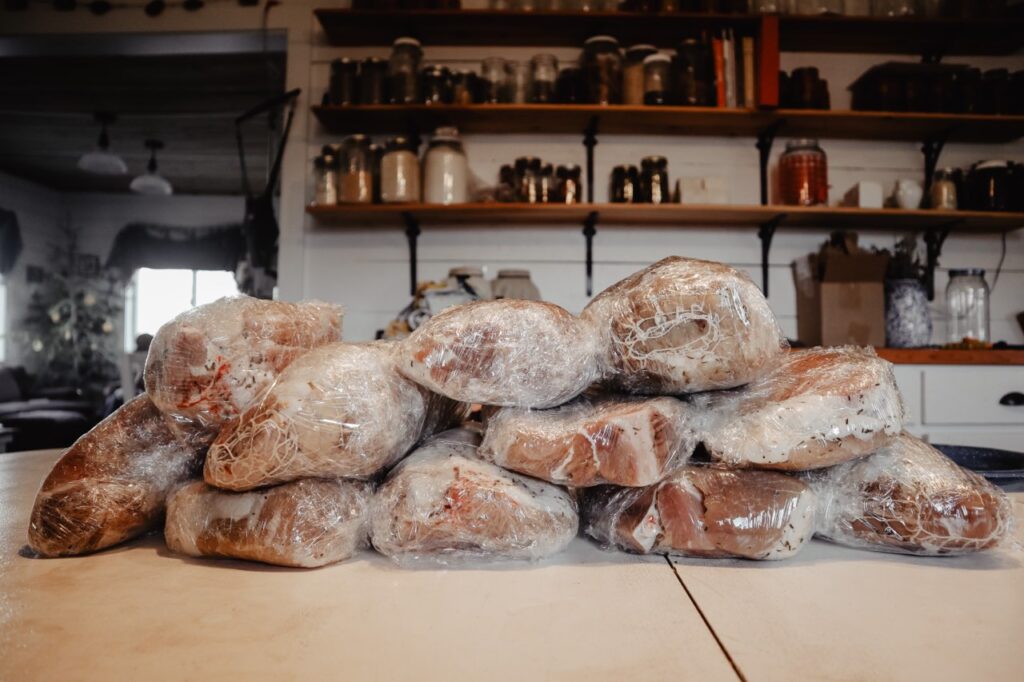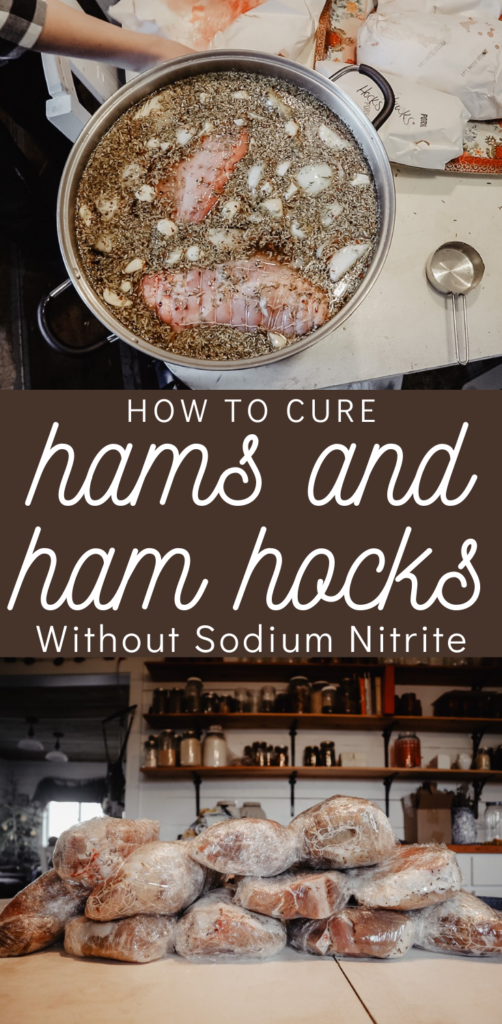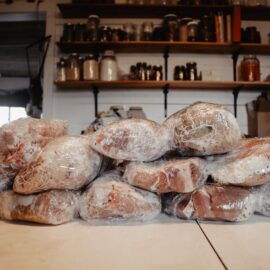How To Cure Ham Without Sodium Nitrite
This post may contain affiliate links. Read my disclosure policy here.
Jump to RecipeThere is something so satisfying about being involved in every process of taking an animal from living in the pasture, to the dinner table.
I love that we know the farmer who raised our hogs.
What they were fed.
How they were cared for.
And that I’m able to be there for the butcher, cut and wrap if I want to.
And then that I can bring home the hams and different cuts like bacon, and cure them myself.
I like being involved in this process.
It makes it that much more delicious and enjoyable to eat the meat!
And it gives me peace of mind as a mother, wife and the cook of the house, that I am feeding my family only the highest quality, healthy meats.
Therefore, I made sure to find a good recipe to brine and cure this ham that didn’t have sodium nitrite.
Why shouldn’t I use sodium nitrite to cure meat?
Most store-bought meats are preserved with sodium nitrite.
The food industry widely uses sodium nitrite to add flavor and red or pink coloring to bacon, ham, hot dogs and other meats. It is also used to reduce moisture content, creating a hostile environment for botulism-causing bacteria. So, the benefit to using sodium nitrite to cure meats, is that the risk of food spoilage is reduced and, the food has an unnaturally long shelf life.
But of course, the food industry, as usual, is just interested in making money, not about making the food safe to eat.
Making the food last longer so they can ship it to different places and making it seem desirable that the meat lasts an unnaturally long time. Not taking into consideration that sodium nitrite has some pretty scare health risks.
Sodium nitrite could increase your chances of developing heart disease. It can damage your blood vessels, making your arteries more likely to harden and narrow, leading to heart disease. High levels can cause problems such as colorectal cancer. Other diseases such as leukemia, non-Hodgkin lymphoma, heart disease, and ovarian, stomach, esophageal, pancreatic and thyroid cancers, may be linked to excessive consumption of sodium nitrate. Some people are extra sensitive to nitrites in cured meats and may experience side effects like migraines.
Curing meat without sodium nitrites
But here’s the good news for y’all.
It is totally possible to cure you ham without these yucky preservatives.
There are two main methods for curing without sodium nitrites.
The first is the dry curing method. This is mainly used for smaller cuts of meat, like bacon or small hams. The curing salt and spices are rubbed onto the surface of the meat and then placed in the refrigerator in a sealed bag or tupperware. This is the method I use for my bacon curing recipe.
The second is the method we are using today, which is brine curing. This is a great way to cure especially large cuts of meat. Which is part of the reason I like to use it for my hams. Normally you make a brine with water, salt, sugar, spices, etc to make a brine and you keep the meat completely submerged in the liquid and in the refrigerator. If the cut is especially big the brine can be injected into the meat with an injector pump (a large perforated needle with holes to release the brine).
Watch this recipe on YouTube!
How To Cure Ham Without Sodium Nitrite
- 2 cups salt
- 2 cups brown sugar
- 1/2 cup fennel seeds
- 1/2 cup mustard seeds
- 2 tablespoons crushed red pepper flakes
- 1/2 tsp dried rosemary or 1 sprig of fresh
- 1 tsp dried thyme or 4 sprigs fresh
- 6 bay leaves
- 1 onion, cut into quarters
- 4 ribs celery, coarsely chopped
- 20 whole garlic cloves, lightly crushed with side of a knife
- 2 gallons water
Combine all the ingredients in a large container/pot/tub/5 gallon bucket, whatever you have. My mom always uses 5 gallon buckets, but I don’t have room in my refrigerator for those. So I used my stock pot, crock pot, dutch oven and instant pot insert haha It was intense.
But again, I did get a whole hog. So there was a LOT of hams.
Den ya stir it up.
Place the meat in the container. Be sure the meat is entirely submerged before replacing the lid. It does float for if necessary, place a plate or other weight on top of the meat to keep it covered with the brine.

Carefully put all the containers in the refrigerator like a jigsaw puzzle.
That is literally what it felt like.
And leave em in the fridge for 3 days.
Take the ham out of the brine and rinse well with cool water to remove all trace of salt. And lightly pat dry with a towel.
Allow the ham to continue to air-dry in the refrigerator on a rack for another 24 hours before cooking or freezing. When I made this last I didn’t have fridge space because I needed to cure the bacon at the same time. So I just made sure they were extra dry with the towel and let them sit on the table on a rack for like 30 minutes.
Storage
When I made these this year I wanted to just freeze them to save for special occasions. So I wrapped them well in plastic wrap and normally they should be wrapped over that with meat freezer paper. But I didn’t have any so I put them in some ziplock bags.

Then I set them all in the freezer spaced out so they could freeze faster, and then I organized them all into a nice neat pile later on.
When you are ready to cook a ham, just follow your favorite recipe as usual!
And man will you be happy you put in this work when you’re enjoying hams during Christmas!
And blessings.
Pin it for later!

Print out the recipe for later!

How To Cure Ham
Ingredients
- 2 cups salt
- 2 cups brown sugar
- 1/2 cup fennel seed
- 1/2 cup mustard seed
- 2 tbsp crushed red pepper flakes
- 1/2 tsp dried rosemary or 1 sprig of fresh
- 1 tsp dried thyme or 4 sprigs fresh
- 6 bay leaves
- 1 onion cut into quarters
- 4 stalks celery coursely chopped
- 25 whole garlic cloves lightly crushed
- 2 gallons filtered water
Instructions
- Combine all the ingredients in a large container/pot/tub/5 gallon bucket, whatever you have. Stir it up.
- Place the meat in the container. Be sure the meat is entirely submerged before replacing the lid. If necessary, place a plate or other weight on top of the meat to keep it covered with the brine.
- Place in the refrigerator and let it cure for 3 days.
- Take the ham out of the brine and rinse well with cool water to remove all trace of salt; lightly pat dry with a cloth towel.
- Allow the ham to continue to air-dry in the refrigerator on a rack for another 24 hours before cooking or freezing.

If I’m only brining a 4-5 pound ham, can I freeze the remaining brine for future use?
Thank you for the gorgeous recipe. How do you prefer to cook your brined ham?
Which cuts of the hog did you use? The shapes didn’t look like a traditional ham. I’m excited to learn what cuts can be used.
I’m working on this now, and I’m so excited! I just took it out of the brine, and I’m putting it on a rack in my roaster oven (which has a lid), and I’ll put it in the fridge for 24 hours. Then I’m planning to cook it & make soup out of it, which I will can.
This might sound strange, but… I hate wasting anything. Do you think there is any use for the brine after the ham has cured in it? Could I maybe re-use it for another batch of ham?
Great post.
Hi, can you cure it without adding any salt?
Salt is a pretty important ingredient, I wouldn’t.
Hi there, thanks for this, I’m actually about to brine a 2kg piece of leg to try it out. I started to mix the ingredients and I have just relamiese that your dosage here is for all the hams you prepared.
Can you please tell me how much meat (weight) did you brine with all this brine?
Thanks!
Have you ever tried the recipe? Your 2kg is just a bit smaller than the smallest shoulder cut that I found. I wanted the flavor to get all the way into the bone (as well as the curing process). My vessel holds 1/4 of the recipe so I was firm in keeping the salt proportion at 1/4 as well. I hope you tried it, 4 days should suffice but I always keep in mind that the goal is to prevent dangerous bacteria. While I also had glazed, the flavor of this recipe is so mellow and wonderful that glazing gets in the way. I can understand glazing a store bought city ham but wow, and I apologize for hijacking the post. The author hadn’t responded in a while and I’ve used this recipe 3x already.
Hi there’s no mention of weight of ham here? I saw someone else asked and you haven’t answered? Or if anyone who has had success with this recipe could let me know what weight ham they used please?
I use the 1 day per pound rule. If I were you, try finding a small cut and use a 2 gallon bag or what I used, a very vertical deep Rubbermaid cereal container. Don’t cut back on the salt. I just reviewed below, cut the fluid recipe by 1/4 and there was more than enough to cover the meat in said vessel. Use a long enough spoon to soft-stir at the bottom every full day – my brine was in for five days for a 4.8lb cut. You’re not losing much if you think it’s too salty and want to cut back the next time. Mine is just a bit salty but jeez it’s better than any city ham that I have ever had in my life.
So if I use the 1 day per lb method, and I have 2 hams brining together that each weigh between 6 and 7 lbs, would that mean 7 days or 14?
With the purchase of an automated pellet smoker at WallyWorld (not the real box store) I’ve been getting bold with doing home cooking. This time it’s with green ham – being single I don’t need a huge one so I’ve been getting small cuts of what’s available, typically shoulder cut of 4-5 lb. First one I added almost twice the sugar as salt. But I guess cured at only 2 days. This time I added 1.5x the sugar. Wasn’t worried about adding some extra garlic and a couple extra sprigs of fresh rosemary & thyme yet mixing 1/4 of the brine which was ample for surrounding & covering the 4.8 lb cut, which was set in a huge plastic Rubbermaid cereal container after scoring the skin. Each 24hr I’d softly stir and adjust the meat placement in this perfect vessel. Today was the end of brine, fired up the Pit Boss with the championship blend pellets. Definitely use a thermometer (mine is digital with receiver which sounded several hours at 165°, spritzing every hour with apple juice. Listen. This is the most delectable ham that I’ve ever experienced. The mix of spices is amazingly complementary to the ham. There’s debate about whether the cut the fat away. I scored sometimes breaching into the meat but no worries. A fun byproduct is pulling the cooked skin away which is so chewy and tasty bc of the juice spritzing over time! Cannot underscore the absolute lusciousness of this recipe!
If you inject the brine in the larger pieces, you can’t rinse that off. seems that would mean excessive saltiness.
I have a 4lb ham to cure. How big of a ham is this recipe for?
Hi how long do the cured meat last for in the deep freeze expiry date before we cook them ? Thanks for ya recipe
Why don’t you ever answer people here?!
It’s interesting that the author has answered NONE of the questions here in over three years. Must be too busy with their pigs.